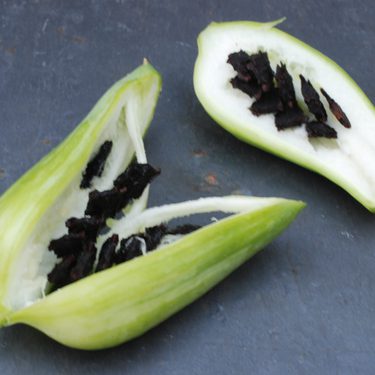
Achocha (Cyclanthera pedata)
- Tags
- unusual veg
| Growing calendar | |
|---|---|
| Sow indoors | April - May |
| Plant out | May - June |
| Harvest | As soon as fruit reaches edible size from late July until frosts |
Achocha has been cultivated by some Asian growers as a UK substitute for the stuffing gourd (Parwal), which needs higher temperatures.
The plant needs warm, humid conditions and, it's claimed, can be more resistant to cold than cucumbers.
The hollow, elongated fruits can reach up to 15cm/6in long and taste like a mixture of cucumber and green pepper: they’re good raw (when young) or cooked. There are several cultivars, although relatively few are available through seed catalogues.
How to grow achocha
Sow two seeds per 9cm/3in pot, or singly in large modules in peat-free compost. Cover lightly and keep in a bright warm place, around 20-25°C/68 -77°F, out of direct sunlight. Germination will take around 10 days, and the weaker seedling should be transplanted or discarded. It’s not usually recommended to sow seeds direct.
Achocha plants should be grown on in pots until around the four-leaf stage, when they can be hardened off and planted out in a sunny, well-drained site once conditions are warm enough outside. Space plants at least 35cm/14in apart.
If you grow them in a tunnel or greenhouse, the plants can become invasive and take up a lot of space.
The plants will need some initial support from netting or stakes, but scramble up walls or fences with ease. There is no need to hand pollinate, and the insignificant flowers don’t cross with either cucumbers or squashes. Invasive tendrils and young shoots can be cut back, cooked and eaten. Pinching the tops back once the plants have reached the top of the support is said to encourage fruiting.
This plant can be very productive, so an average family will only need two plants.
Harvesting and using achocha
Fruits can be harvested as soon as they are large enough – some varieties only reach about 5cm long, others much bigger. They don’t change colour as they ripen, but become hollow. After the seeds begin to form, the pods sometimes become fibrous as they age.
Achocha fruits can be eaten raw, fried or pickled. They make excellent substitutes for green peppers and may be stuffed, added to pizza or pasta dishes or in stews and sauces. You will need to remove the seeds from older fruits as they are too tough to eat.
Fruits will keep in the salad tray of the fridge for around 10 days.
Troubleshooting achocha
Usually bombproof, but can suffer from the same viruses as other cucurbits, such as Cucumber Mosaic Virus.
Seed saving
Achocha is very easy to save seed from. It has male and female flowers on each plant, but needs around 10 plants to cross-pollinate, and ensure a good genetic mix. Select a minimum of two to three plants to save seed from, allowing all fruits on them to develop.
Only grow one variety per season, to avoid crossing varieties: isolation distance is around 750m/800 yards. Leave on the plant until full-sized and the pods contain black flat seeds, usually from August. Scoop out the seeds, and allow to dry on greaseproof paper in a cool dark place, before transferring to seed envelopes. Seed life is around four years.

| Growing notes | |
|---|---|
| Difficulty | Easy |
| Germination time | 10-14 days |
| Average time to harvest | 3 months |
| Equipment needed | Space, supports (netting and/or canes) |
| Average plant size | Height 2.5m/7ft, spread 1.5m/4ft |
| Family group to grow with | Cucurbits |
| Seed saving notes | Seed saving notes – doesn’t cross with other cucurbits: self-fertile but better with other achocha plants for cross-pollination. |
| Key nutritional content | Rich in Vitamin C and fibre |